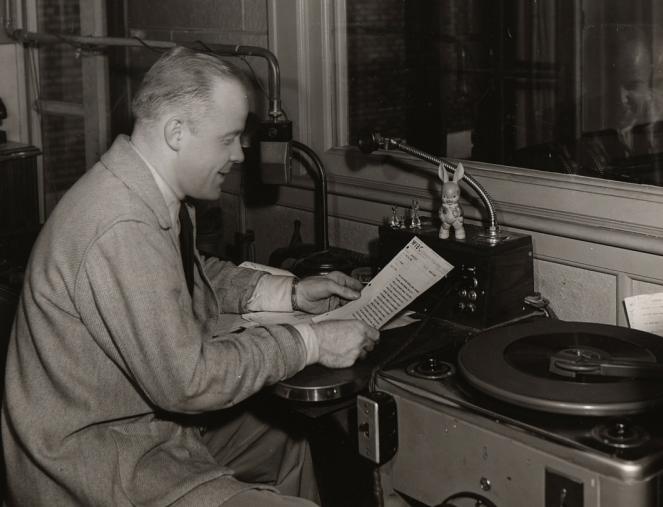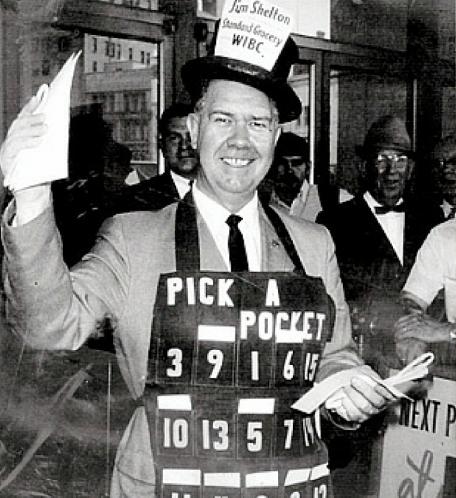WIBC’s official broadcast debut was October 31, 1938. Owned by Glenn Van Auken’s Indiana Broadcasting Company and managed by C. A. McLaughlin, the station broadcast at 1050 kilocycles. In 1941, the Federal Communications Commission changed the dial locations of all Indianapolis radio stations. At that time, WIBC moved to 1070 on the AM dial.

In the 1940s, WIBC’s Easy Gwynn became the city’s first deejay, and newsman broadcast a national news program over WIBC and the Mutual Network, becoming the first Indianapolis newsman with a regular network broadcast. The bought WIBC in 1944, and station general manager bought it in 1948.
Four years later, WIBC and the (IMS) formed the , to broadcast the nationally. was the lead announcer, and he remained the “Voice of the 500” for over 20 years.

During the 1950s, WIBC’s Dick Sumner hosted a nightly popular music program from atop Merrill’s Hi-Decker drive-in and emceed “Pick-A-Pocket,” a man-on-the-street quiz show. In 1956, the Grand Ole’ Opry nominated announcer Jack Morrow “Mr. Dee Jay U.S.A.” for his live-talent country music program. Morrow also hosted weekly gospel concerts from the in Indianapolis, and he ranked second in the nation for on-air sales.
During the 1950s and 1960s as network television eroded the radio market, WIBC transitioned to local news, talk, and music. joined the station in 1957. He became news director in 1961 and retained that position for 32 years. He became well-known for his daily radio essays entitled “My Town Indy.” Heckman held high standards and encouraged his reporters to develop their own stories rather than read from news wire reports.
In the 1970s, other key WIBC personalities included Jerry Baker, the voice of Indiana University Hoosiers basketball and the , and Chuck Riley, who anchored the afternoon broadcast before becoming a successful voice-over talent in Los Angeles. “Hockey Bob” Lamey was another sports broadcaster for WIBC. He earned his nickname doing play-by-play coverage of the Indianapolis Racers WHA team before he became the voice of the after they moved to Indianapolis in 1984.
Paul Page followed Sid Collins for the Speedway Radio Network as the “Voice of the 500” from WIBC and later served the same role on TV. Page also was an award-winning newsman. He reported from the first Indianapolis-area traffic helicopter that became known as the “Ten Seven-Oh Whirlybird.” Page and his pilot abandoned the traffic helicopter in 1977 following a serious crash that nearly killed them.

WIBC’s focus on news kept it among the most listened to in the city even after other AM stations lost the majority of their audiences to FM radio. Breaking coverage of incidents such as the at the indiana State Fairgrounds Coliseum and Heckman’s at-the-scene arbitration during the 1977 kept the station at the forefront of radio news coverage even as others were downsizing or eliminating their news teams.
In 1985, WIBC ranked first among area stations in Arbitron ratings. Its popular morning program hosted by Gary Todd battled with the equally popular “Bob and Tom Show” on for many years before finally losing the first place position in 1988. In 1989, WIBC’s news-and-information format earned the station three-fourths of the $12 million in total AM revenue in the area.
Sconnix Broadcasting Company purchased WIBC in 1987 and by the early 1990s had begun making significant changes to the news format. The station shifted from “police blotter style” to “headlines” news, eliminating four people from its news staff in the process. In 1992, WIBC lost the contract to broadcast games to /WFBQ. The controversial retirements of longtime newsman Joe Pickett in 1991 and news director Heckman in 1993 brought negative publicity and age discrimination complaints.
By the summer of 1993, having adopted a “talk-radio” format, WIBC ranked third in the city’s Arbitron ratings with a 10.4 share of the available audience. The station maintained a strong following for morning and afternoon drive time and especially for midday programming. Although lower than its first-place ranking in 1987, this showing was still the highest among area AM stations.

On April 11, 1993, WIBC added conservative commentator and radio host, Rush Limbaugh, to its lineup. While ratings skyrocketed during Limbaugh’s 2 to 3 PM show, morning ratings plummeted. The station became identified with Limbaugh’s show. The addition of another conservative talk-show host, Stan Solomon, added to WIBC’s reputation as right-winged. This programming polarized listeners. Many abandoned the station, and WIBC lost its reputation as “the friendly voice of Indiana.”
Emmis Broadcasting () announced on April 15, 1994, its purchase of the station from Sconnix. Jeff Smulyan, Emmis founder and CEO, later stated that he purchased the station “because it had always been sort of a legendary standard” in the Indianapolis community and its image “had fallen into disrepair.” Within a year, Smulyan had fired Stan Solomon. He brought back Heckman as news director emeritus, along with his “My Town Indy.” Heckman remained with the station until he retired in 2000.
In addition, play-by-play broadcasts of the Indianapolis Colts and the Indiana Pacers returned to WIBC. The Indianapolis Motor Speedway also signed an agreement with the station, making it the exclusive broadcast outlet for the race. For several years, IMS had allowed several stations to carry the 500.
In 1998, WIBC moved to Emmis Communications’ new headquarters on . The station won the NAB Marconi Award for News/Talk Station of the Year, which is equivalent to winning an Emmy for TV.
When Emmis acquired the rights to broadcast Indianapolis Colts games for the 2007 season, WIBC had rights for all Indianapolis major sports teams. Smulyan sold WNOW (“Radio Now”) to Radio One, which changed frequencies, clearing 93.1 FM for WIBC. On December 26, 2008, Emmis launched , “The Fan,” on WIBC’s former 1070 AM frequency. It took over the frequency as the first 24-hour sports-talk radio station. It discontinued broadcasting on the AM frequency in August 2021, although Emmis announced that it hoped to find a future use for 1070.
As an FM station, WIBC received another NAB Marconi award in 2009, this time for Large Market Station of the Year. It dropped the in July 2015, abandoning the conservative talk format.
WIBC broadcasts from a state-of-the-art, street-level showcase studio in the Emmis Communications Headquarters and remains a top-rated Indianapolis talk radio station.
In 2021, the company announced that it was abandoning WIBC’s longtime former home on the airwaves—1070 AM—with the sale of its broadcast towers. Then in the face of a shrinking radio market, Emmis Communications announced the sale of its Indianapolis radio stations, which in addition to WIBC also included the popular sports station The Fan (93.5 FM and 107.5 FM), B105 (WYXB 105.7 FM), and HANK FM (97.1 FM), to Maryland-based Urban One in June 2022.

Help improve this entry
Contribute information, offer corrections, suggest images.
You can also recommend new entries related to this topic.